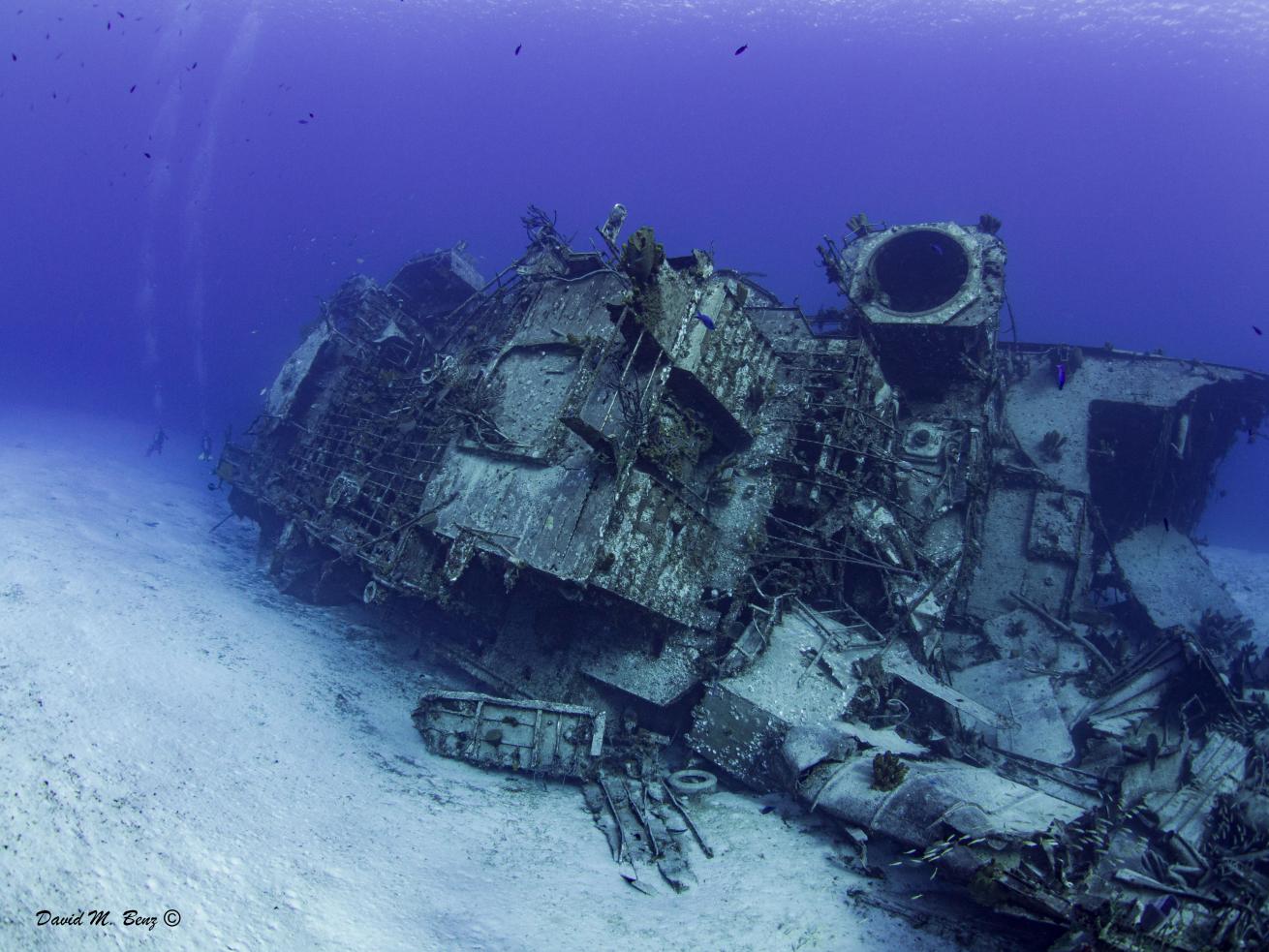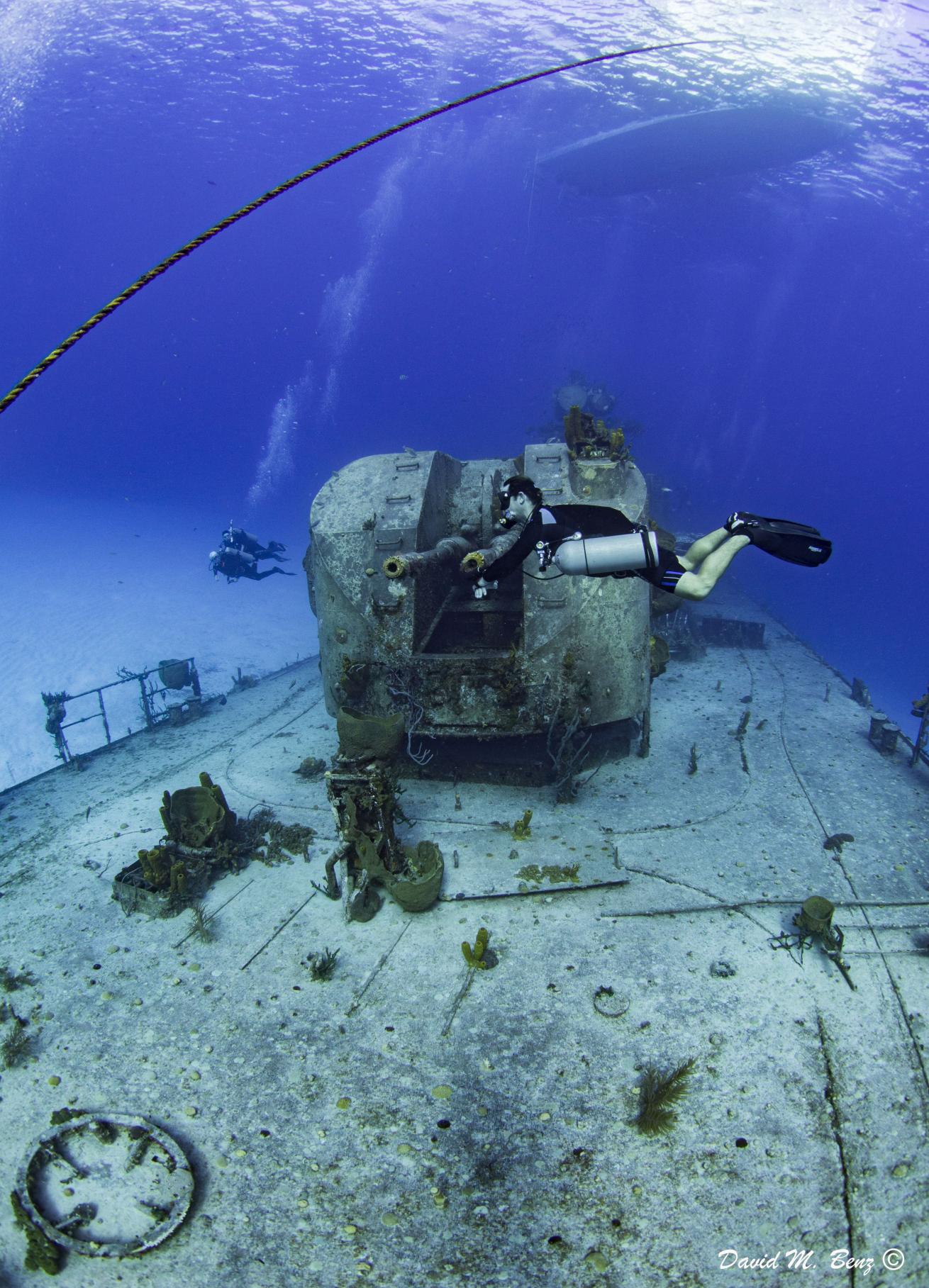M/V Captain Keith Tibbetts, Cayman Brac

David M. BenzThis frigate was deliberately scuttled in 1996. Divers have been witness to its history ever since.
The government of the Cayman Islands is world-renowned for encouraging dive tourism both ecologically and financially for many decades, including its ambitious effort 27 years ago to convert retired 330-foot Cuban Navy frigate into an artificial reef. The sinking of the Russian-built gunship — off the northwest side of Cayman Brac — was scheduled in September 1996 with considerable fanfare and carefully overseen by Jean-Michel Cousteau.
The plan called for the wreck to be set in 60 to 90 feet of water, making it accessible to divers of almost all levels of experience. The sinking went brilliantly, with the wreck sitting upright in the sand and positioned between two natural reefs. It was renamed M/V Captain Keith Tibbetts —for a local dive operator — and the wreck was an instant favorite of visiting divers and local marine dwellers alike. Hurricane Ivan in 2004 added its own twist to the wreck, quite literally, as the ship was torn in half, and subsequent storms have also nudged and adjusted features. But most of these events have only made things more interesting at this unique site.
If you are feeling in need of exercise, the wreck can be reached with a 200+ yard surface swim from shore. But the site is accessible by boat from both Cayman Brac and Little Cayman, which makes for a more leisurely approach to either of the two moorings — one is attached to the bow and the other to the stern. Dive guides provide a great briefing with overview drawings that illustrate how the wreck is oriented and highlight its prominent features, so you know what to expect.
Navigation is easy in the clear, calm waters of the Caribbean Sea. A descent to the bow on the deeper end of the Tibbetts reveals it now leans on its port side. As you drop down on the structure, it is not uncommon to pass hundreds of sergeant majors cavorting above the structure, and you’ll find the railings are festooned with sponges and corals. When you reach the bow deck you cannot miss the impressive gun turrets, which now serve a far more peaceful purpose as a marine habitat, including the clusters of yellow tube sponges that add a burst of color and beauty. The superstructure has been a bit roughed up by numerous storms, but the aquatic life seems to enjoy the chaos of cables, pipes and structural beams. Wreck divers know that the more complicated the structure, the greater the number of small gem-like fish that dart in and out of every nook.

David M. BenzThe broken midsection of the Tibbetts initially looks like a jumbled heap of metal, but on closer inspection, divers will see that all the broken debris is throbbing with life.
Heading toward midships, you will be under the wary eye of young barracudas and Nassau groupers. A spotted eagle ray may come flying by as they often soar along the side of the wreck. The broken midsection of the Tibbetts initially looks like a jumbled heap of metal, hardware, pipes and cables, but on closer inspection, divers will see that all the broken debris is throbbing with life. Shy denizens such as octopus and young grouper can be found hiding in broken pipes. Clouds formed by millions of minute fry in this active tropical nursery create a pulsing haze over this section, which attracts larger fish species. Rippling schools of creole wrasse may come parading through at any moment.
This part of the wreck also offers the opportunity for limited penetration if you have the training to do so. Clearly the gray angelfish and snapper have had this training, as they come and go through the engine room regularly.
As you head gradually shallower toward the stern, you’ll find that hard and soft corals, as well as larger sponges, become more abundant on the metal surface. If you are lucky, you might find a hawksbill sea turtle feeding on the deck, tearing into some of the bigger sponges, oblivious to everything else as it feasts. A small part of the superstructure is open in this area, and you will find another imposing gun turret. The door to the turret is flung open, and you can peek inside and imagine how intense the tight space would have been in action. After nearly three decades on the seafloor, the only action you’ll be part of today is to be surrounded by swirling schools of pretty damselfish. The overhead sun casts dancing ripples of light over the entirety of this part of the wreck, creating the tranquil illusion of movement. But the real beauty of the M/V Captain Keith Tibbetts is to see the thriving reef this former warship has become with an untold number of full-time marine residents that will foster many more generations in the future.
If your pressure gauge says you have had enough, it is just a short swim to your safety stop. But if you still have some dive time left, you might check out the nearby mounding reefs that support a busy marine community of their own. By the end of the dive, you will discover that with so much to explore, this dive site is worthy of more than one visit.
What to Know
Language: English
Currency: Cayman Islands dollar
Signature Dish: Fish rundown, a stew made with coconut-milk-soaked fish.
Signature Topside Activity: Queen Elizabeth II Botanic Park, Grand Cayman; Owen Island, Little Cayman; Bat Cave, Cayman Brac.
Main Airport: Grand Cayman’s Owen Roberts International Airport (GCM).
Water Temp/Visibility: High 70s to low 80s/80 to 100 feet.
Travel Tip: Carry both Cayman and U.S. dollars — resorts and hotels usually quote prices in U.S. dollars, while restaurants and shops ask for Cayman Islands dollars.
Click Here for More Information










